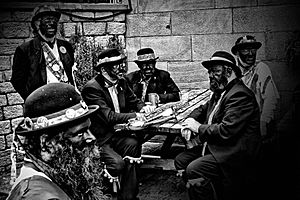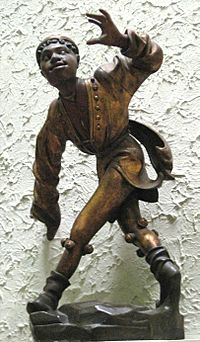Blackface and Morris dancing facts for kids
Have you ever heard of Morris dancing? It's a traditional English folk dance, often performed by groups of dancers wearing special costumes and bells. Sometimes, these dancers paint their faces black. This practice, known as blackface, has a long and interesting history. People have different ideas about how it started. One popular idea is that it's connected to very old Morris dancing traditions.
Contents
What is Morris Dancing?
Morris dancing is a type of English folk dance. It often involves dancers wearing bells on their legs and using handkerchiefs or sticks. The word Morris might come from the old English word morys, which is a version of moorish. This word refers to the Moors, who were people from Morocco. This idea about the name has been around since at least 1801.
Early Moorish Dancers
In Munich, Germany, there are carved figures from 1480 called "Moriskentänzer" (Moorish dancers). These figures wear bells. One of them even has features that look African.
Later, around 1580, a French writer named Thoinot Arbeau wrote about a dance. He said that after dinner, a small boy with a black face and a white or yellow scarf would appear. He wore leggings with bells and performed a "morris" dance. It's not clear how closely this French morris dance was linked to the English one at that time. However, King Henry VII might have seen French morris dances. Records show he had morris dancers at his own court in England.
Another idea is that the blackface tradition came from even older dances. These dances might have involved a Moroccan king and his followers. In 1688, records from Shrewsbury show payments to "Ye Bedlam Morris" and "Ye King of Morocco." This suggests a link between Morris dancing and a "King of Morocco" figure.
Black Faces in the 1700s
In the 1700s, people also connected black faces with Morris dancing. For example, the Betley Window is a stained-glass window from around 1621. It shows Morris dancers. In 1778, the window's owner, George Tollet, described it. He said that none of the dancers had black or dark faces. This suggests that by his time, black faces were sometimes expected in Morris dancing.
Some experts, like Cecil Sharp, wondered if English Morris dance was really linked to Moorish dances from Europe. Sharp thought the English dance style was too different. He later changed his mind, seeing a possible link between black faces in English morris and dancers near the French-Spanish border. He also suggested that "Moorish" might have been a description for an older dance, not because the dancers were actually Moors.
Pagan Dance Theory
Another idea connects English Morris dance to mouriscada or morisca dances from Spain and Portugal. These dances often showed pretend battles between Christians and Moors. Some wonder if this Christian-Moorish link came later. Perhaps the dances were originally older, pagan mock battles, like those between Summer and Winter on May Day.
In some parts of Portugal and the Basque Country, the word moor can also mean 'pagan'. So, some believe that Morris dance originally meant 'pagan dance'. Bells and disguised faces are common in pagan rituals. This idea suggests that the Moorish link is just a coincidence, and the true origins are much older and pagan. Many people still believe this today.
Why Disguise?
Blackface and other forms of disguise have a long history, often linked to pagan traditions. Since the 1450s, people have used charcoal to blacken their faces. This was a way to hide their identity. It was also linked to pagan themes. For example, during riots in Kent and Essex in the 1450s, men dressed as the 'Fairy Queen' and some wore blackface.
Early Morris Disguises
One of the earliest mentions of Morris dance in England is from 1501. King Henry VII paid someone to make a "disguising for a morysse." This shows that Morris dance was already connected to costumes and disguises.
Later, in 1509, during a banquet for King Henry VIII, torchbearers were dressed "like Moreskoes, their faces blacke." The next year, in 1510, a "Pageant like a mountain" featured children who "danced a Morice before the Kyng." They were "freshly disguysed."
Records from around 1510 also mention rules for "plays, interludes and disguisings, including Morrises." It says, "If a Morris is to be performed, it should take place after the disguising." This clearly shows that by the early 1500s, Morris dance was linked to blackened faces and other elaborate costumes.
In 1584, in Shrewsbury, people were asked if there were any "disguised persons, as morice dancers, maskers or mumm'ers." This proves that in Shrewsbury, Morris dancers were seen as people in disguise during the 1500s.
Hiding Identity
The idea of disguise also explains blackface in later times. During the cold winters of the 1600s and 1700s, workers who had no jobs would dance and beg for money. They used blackface as a way to hide who they were. This way, they could earn money without being easily recognized. By the 1700s, using blackface as a disguise was common in England.
Morris and Minstrel Shows
In the late 1830s, American minstrel shows became popular in Victorian England. Minstrel shows often featured performers with blackface. Some people wonder if these shows influenced Morris dancing.
Some experts, like Theresa Buckland, have studied the link between the 1800s Lancashire Britannia Coconut Dancers and minstrel shows. She suggests that the idea of "disguise" for the black face in Morris dancing might have been influenced by later interpretations.
According to the American Morris News in 2005, many people believe that blackface in Morris dancing started as a simple disguise, not as an imitation of Black people. However, they also note that Morris dances from Shakespeare's time don't mention blackface. But Morris teams around the time of minstrel shows often did blacken their faces. This suggests that even if minstrel shows weren't the original reason for blackface in Morris dancing, they might have made it more popular.



